Quinine Medication in Malaria Treatment: A Comprehensive Report
VerifiedAdded on 2023/01/16
|6
|1518
|35
Report
AI Summary
This report provides an overview of malaria, a disease transmitted by mosquitoes and caused by the parasite Plasmodium vivax, and the use of quinine in its treatment. It discusses the drug's mechanism of action, including how it affects the parasite's digestion of hemoglobin and prevents the formation of beta-haematin. The report details the absorption and metabolism of quinine, including its affinity for proteins and the role of cytochrome P-450 enzymes. It also covers the side effects of quinine, such as nosebleeds and dizziness, and the use of drug-resistant compounds to mitigate these effects. Furthermore, the report contrasts quinine with modern medications like Artemether-lumefantrine, particularly in severe cases, while also mentioning other medications used in malaria treatment. The report concludes that while quinine is an older drug, its use is still relevant in primary malaria intervention, but modern treatments may be more effective in severe conditions.
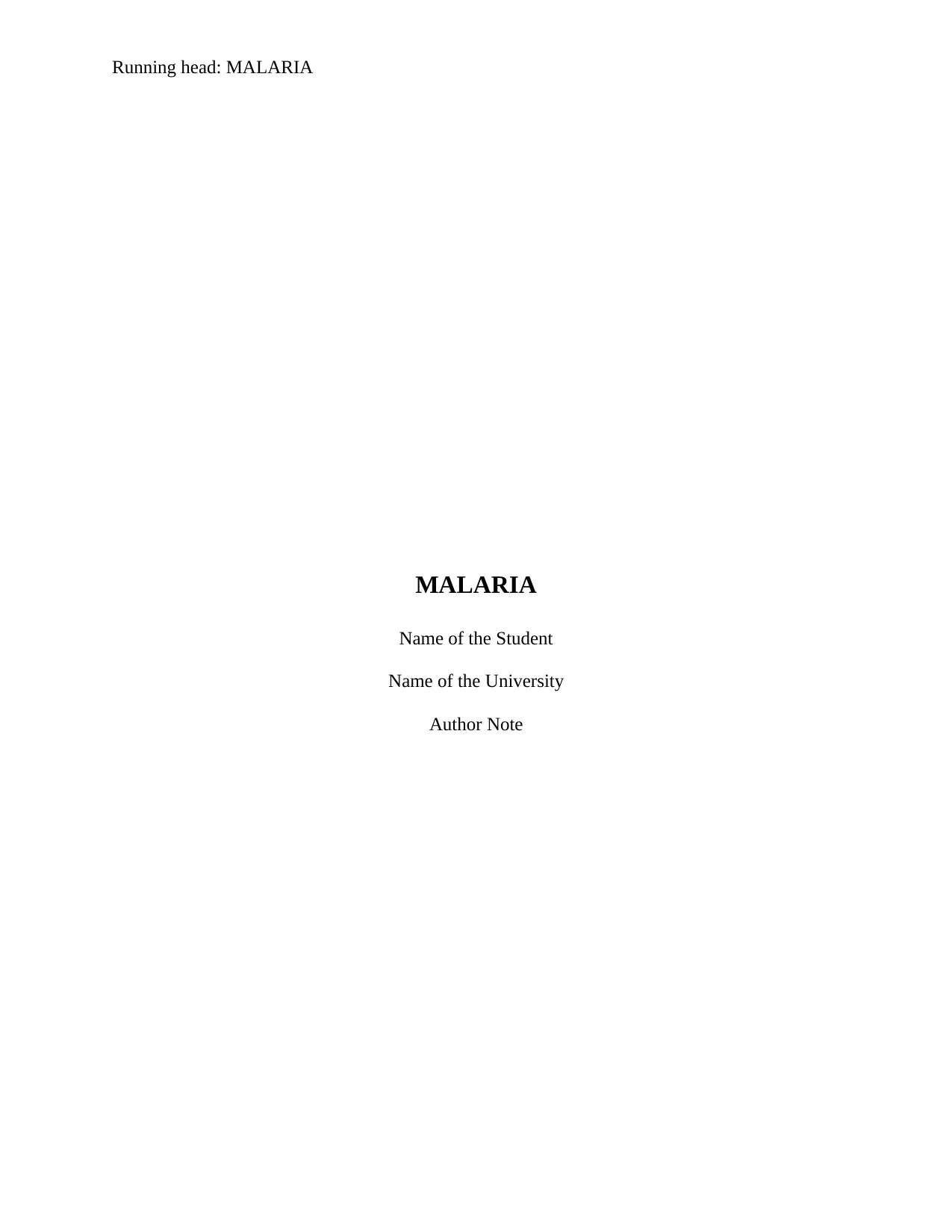
Running head: MALARIA
MALARIA
Name of the Student
Name of the University
Author Note
MALARIA
Name of the Student
Name of the University
Author Note
Paraphrase This Document
Need a fresh take? Get an instant paraphrase of this document with our AI Paraphraser
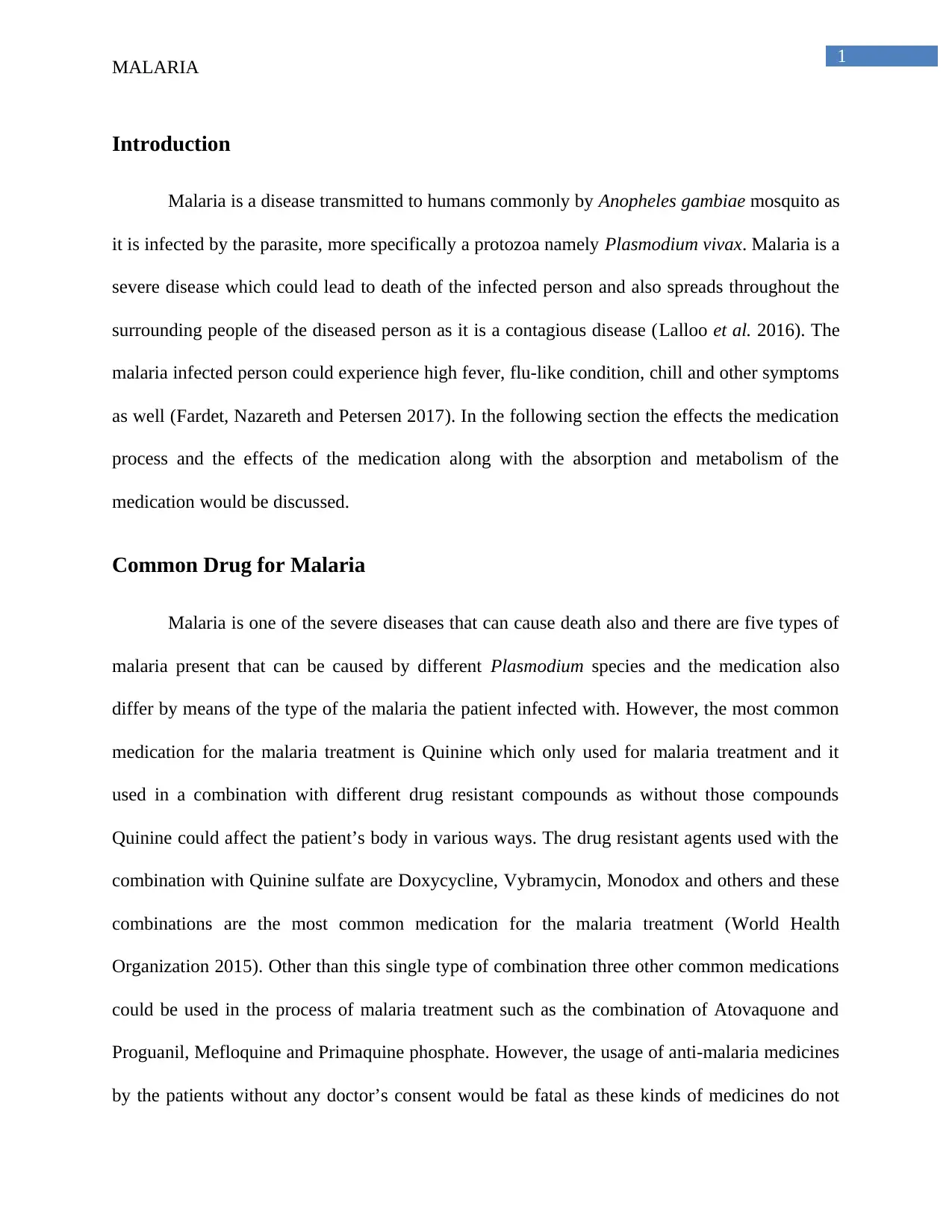
1
MALARIA
Introduction
Malaria is a disease transmitted to humans commonly by Anopheles gambiae mosquito as
it is infected by the parasite, more specifically a protozoa namely Plasmodium vivax. Malaria is a
severe disease which could lead to death of the infected person and also spreads throughout the
surrounding people of the diseased person as it is a contagious disease (Lalloo et al. 2016). The
malaria infected person could experience high fever, flu-like condition, chill and other symptoms
as well (Fardet, Nazareth and Petersen 2017). In the following section the effects the medication
process and the effects of the medication along with the absorption and metabolism of the
medication would be discussed.
Common Drug for Malaria
Malaria is one of the severe diseases that can cause death also and there are five types of
malaria present that can be caused by different Plasmodium species and the medication also
differ by means of the type of the malaria the patient infected with. However, the most common
medication for the malaria treatment is Quinine which only used for malaria treatment and it
used in a combination with different drug resistant compounds as without those compounds
Quinine could affect the patient’s body in various ways. The drug resistant agents used with the
combination with Quinine sulfate are Doxycycline, Vybramycin, Monodox and others and these
combinations are the most common medication for the malaria treatment (World Health
Organization 2015). Other than this single type of combination three other common medications
could be used in the process of malaria treatment such as the combination of Atovaquone and
Proguanil, Mefloquine and Primaquine phosphate. However, the usage of anti-malaria medicines
by the patients without any doctor’s consent would be fatal as these kinds of medicines do not
MALARIA
Introduction
Malaria is a disease transmitted to humans commonly by Anopheles gambiae mosquito as
it is infected by the parasite, more specifically a protozoa namely Plasmodium vivax. Malaria is a
severe disease which could lead to death of the infected person and also spreads throughout the
surrounding people of the diseased person as it is a contagious disease (Lalloo et al. 2016). The
malaria infected person could experience high fever, flu-like condition, chill and other symptoms
as well (Fardet, Nazareth and Petersen 2017). In the following section the effects the medication
process and the effects of the medication along with the absorption and metabolism of the
medication would be discussed.
Common Drug for Malaria
Malaria is one of the severe diseases that can cause death also and there are five types of
malaria present that can be caused by different Plasmodium species and the medication also
differ by means of the type of the malaria the patient infected with. However, the most common
medication for the malaria treatment is Quinine which only used for malaria treatment and it
used in a combination with different drug resistant compounds as without those compounds
Quinine could affect the patient’s body in various ways. The drug resistant agents used with the
combination with Quinine sulfate are Doxycycline, Vybramycin, Monodox and others and these
combinations are the most common medication for the malaria treatment (World Health
Organization 2015). Other than this single type of combination three other common medications
could be used in the process of malaria treatment such as the combination of Atovaquone and
Proguanil, Mefloquine and Primaquine phosphate. However, the usage of anti-malaria medicines
by the patients without any doctor’s consent would be fatal as these kinds of medicines do not
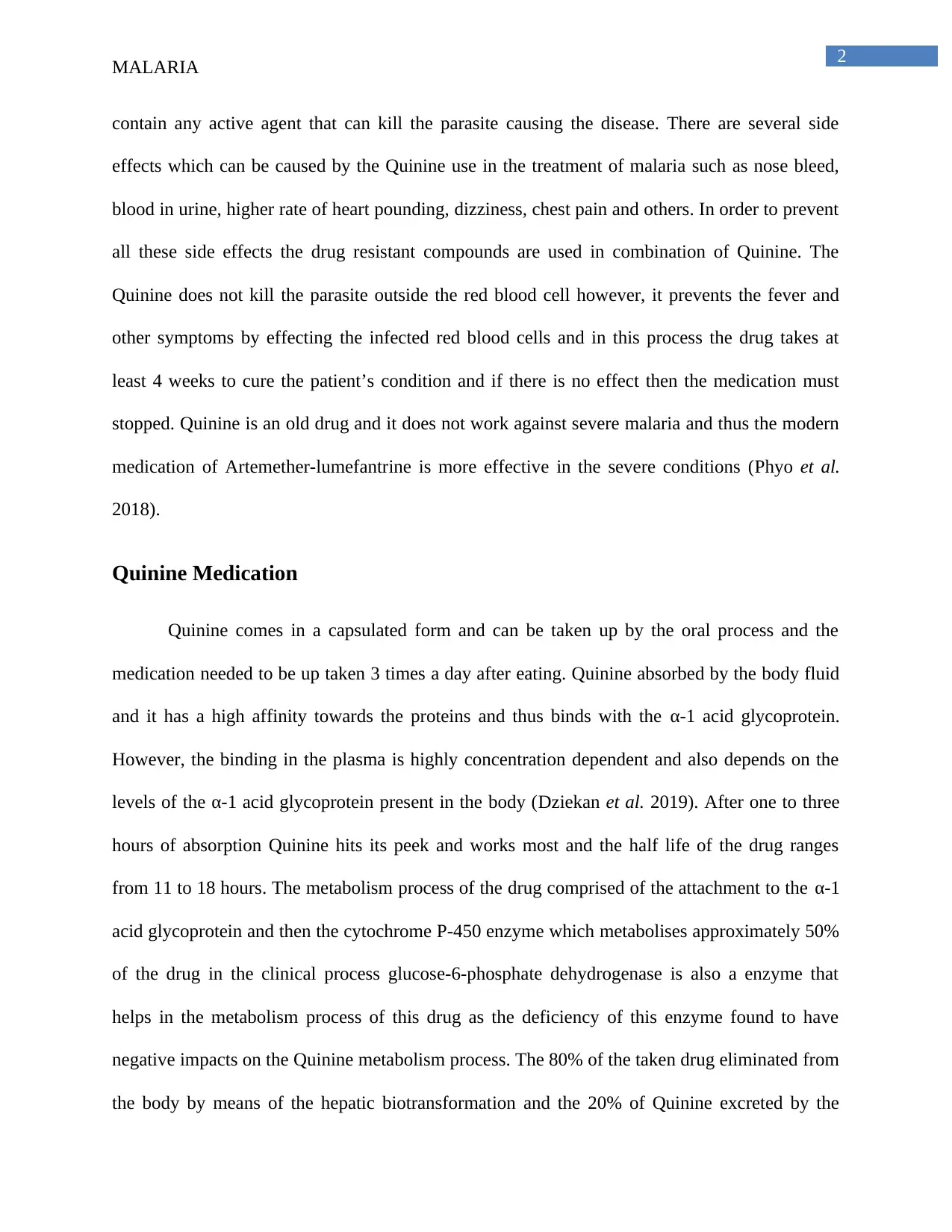
2
MALARIA
contain any active agent that can kill the parasite causing the disease. There are several side
effects which can be caused by the Quinine use in the treatment of malaria such as nose bleed,
blood in urine, higher rate of heart pounding, dizziness, chest pain and others. In order to prevent
all these side effects the drug resistant compounds are used in combination of Quinine. The
Quinine does not kill the parasite outside the red blood cell however, it prevents the fever and
other symptoms by effecting the infected red blood cells and in this process the drug takes at
least 4 weeks to cure the patient’s condition and if there is no effect then the medication must
stopped. Quinine is an old drug and it does not work against severe malaria and thus the modern
medication of Artemether-lumefantrine is more effective in the severe conditions (Phyo et al.
2018).
Quinine Medication
Quinine comes in a capsulated form and can be taken up by the oral process and the
medication needed to be up taken 3 times a day after eating. Quinine absorbed by the body fluid
and it has a high affinity towards the proteins and thus binds with the α-1 acid glycoprotein.
However, the binding in the plasma is highly concentration dependent and also depends on the
levels of the α-1 acid glycoprotein present in the body (Dziekan et al. 2019). After one to three
hours of absorption Quinine hits its peek and works most and the half life of the drug ranges
from 11 to 18 hours. The metabolism process of the drug comprised of the attachment to the α-1
acid glycoprotein and then the cytochrome P-450 enzyme which metabolises approximately 50%
of the drug in the clinical process glucose-6-phosphate dehydrogenase is also a enzyme that
helps in the metabolism process of this drug as the deficiency of this enzyme found to have
negative impacts on the Quinine metabolism process. The 80% of the taken drug eliminated from
the body by means of the hepatic biotransformation and the 20% of Quinine excreted by the
MALARIA
contain any active agent that can kill the parasite causing the disease. There are several side
effects which can be caused by the Quinine use in the treatment of malaria such as nose bleed,
blood in urine, higher rate of heart pounding, dizziness, chest pain and others. In order to prevent
all these side effects the drug resistant compounds are used in combination of Quinine. The
Quinine does not kill the parasite outside the red blood cell however, it prevents the fever and
other symptoms by effecting the infected red blood cells and in this process the drug takes at
least 4 weeks to cure the patient’s condition and if there is no effect then the medication must
stopped. Quinine is an old drug and it does not work against severe malaria and thus the modern
medication of Artemether-lumefantrine is more effective in the severe conditions (Phyo et al.
2018).
Quinine Medication
Quinine comes in a capsulated form and can be taken up by the oral process and the
medication needed to be up taken 3 times a day after eating. Quinine absorbed by the body fluid
and it has a high affinity towards the proteins and thus binds with the α-1 acid glycoprotein.
However, the binding in the plasma is highly concentration dependent and also depends on the
levels of the α-1 acid glycoprotein present in the body (Dziekan et al. 2019). After one to three
hours of absorption Quinine hits its peek and works most and the half life of the drug ranges
from 11 to 18 hours. The metabolism process of the drug comprised of the attachment to the α-1
acid glycoprotein and then the cytochrome P-450 enzyme which metabolises approximately 50%
of the drug in the clinical process glucose-6-phosphate dehydrogenase is also a enzyme that
helps in the metabolism process of this drug as the deficiency of this enzyme found to have
negative impacts on the Quinine metabolism process. The 80% of the taken drug eliminated from
the body by means of the hepatic biotransformation and the 20% of Quinine excreted by the
⊘ This is a preview!⊘
Do you want full access?
Subscribe today to unlock all pages.

Trusted by 1+ million students worldwide
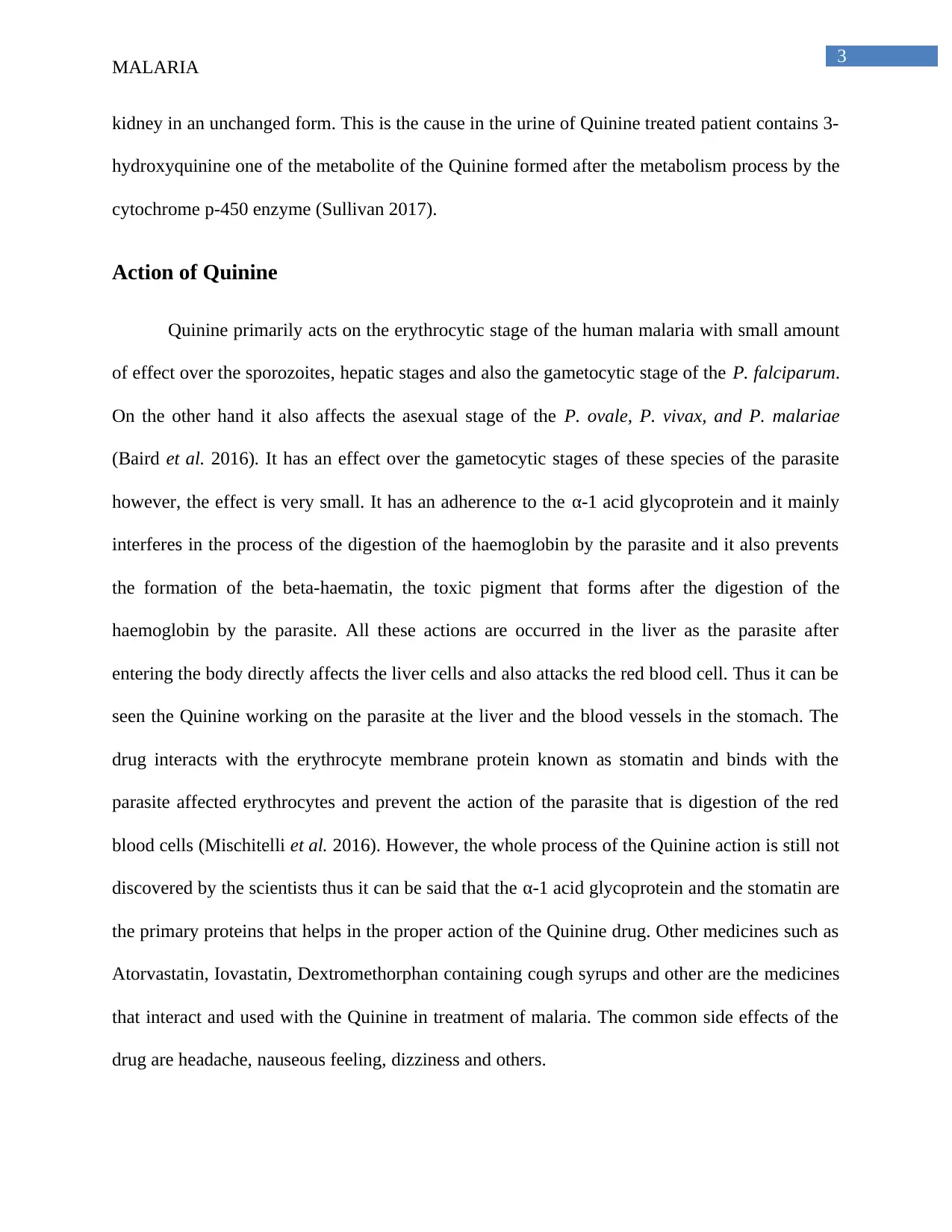
3
MALARIA
kidney in an unchanged form. This is the cause in the urine of Quinine treated patient contains 3-
hydroxyquinine one of the metabolite of the Quinine formed after the metabolism process by the
cytochrome p-450 enzyme (Sullivan 2017).
Action of Quinine
Quinine primarily acts on the erythrocytic stage of the human malaria with small amount
of effect over the sporozoites, hepatic stages and also the gametocytic stage of the P. falciparum.
On the other hand it also affects the asexual stage of the P. ovale, P. vivax, and P. malariae
(Baird et al. 2016). It has an effect over the gametocytic stages of these species of the parasite
however, the effect is very small. It has an adherence to the α-1 acid glycoprotein and it mainly
interferes in the process of the digestion of the haemoglobin by the parasite and it also prevents
the formation of the beta-haematin, the toxic pigment that forms after the digestion of the
haemoglobin by the parasite. All these actions are occurred in the liver as the parasite after
entering the body directly affects the liver cells and also attacks the red blood cell. Thus it can be
seen the Quinine working on the parasite at the liver and the blood vessels in the stomach. The
drug interacts with the erythrocyte membrane protein known as stomatin and binds with the
parasite affected erythrocytes and prevent the action of the parasite that is digestion of the red
blood cells (Mischitelli et al. 2016). However, the whole process of the Quinine action is still not
discovered by the scientists thus it can be said that the α-1 acid glycoprotein and the stomatin are
the primary proteins that helps in the proper action of the Quinine drug. Other medicines such as
Atorvastatin, Iovastatin, Dextromethorphan containing cough syrups and other are the medicines
that interact and used with the Quinine in treatment of malaria. The common side effects of the
drug are headache, nauseous feeling, dizziness and others.
MALARIA
kidney in an unchanged form. This is the cause in the urine of Quinine treated patient contains 3-
hydroxyquinine one of the metabolite of the Quinine formed after the metabolism process by the
cytochrome p-450 enzyme (Sullivan 2017).
Action of Quinine
Quinine primarily acts on the erythrocytic stage of the human malaria with small amount
of effect over the sporozoites, hepatic stages and also the gametocytic stage of the P. falciparum.
On the other hand it also affects the asexual stage of the P. ovale, P. vivax, and P. malariae
(Baird et al. 2016). It has an effect over the gametocytic stages of these species of the parasite
however, the effect is very small. It has an adherence to the α-1 acid glycoprotein and it mainly
interferes in the process of the digestion of the haemoglobin by the parasite and it also prevents
the formation of the beta-haematin, the toxic pigment that forms after the digestion of the
haemoglobin by the parasite. All these actions are occurred in the liver as the parasite after
entering the body directly affects the liver cells and also attacks the red blood cell. Thus it can be
seen the Quinine working on the parasite at the liver and the blood vessels in the stomach. The
drug interacts with the erythrocyte membrane protein known as stomatin and binds with the
parasite affected erythrocytes and prevent the action of the parasite that is digestion of the red
blood cells (Mischitelli et al. 2016). However, the whole process of the Quinine action is still not
discovered by the scientists thus it can be said that the α-1 acid glycoprotein and the stomatin are
the primary proteins that helps in the proper action of the Quinine drug. Other medicines such as
Atorvastatin, Iovastatin, Dextromethorphan containing cough syrups and other are the medicines
that interact and used with the Quinine in treatment of malaria. The common side effects of the
drug are headache, nauseous feeling, dizziness and others.
Paraphrase This Document
Need a fresh take? Get an instant paraphrase of this document with our AI Paraphraser
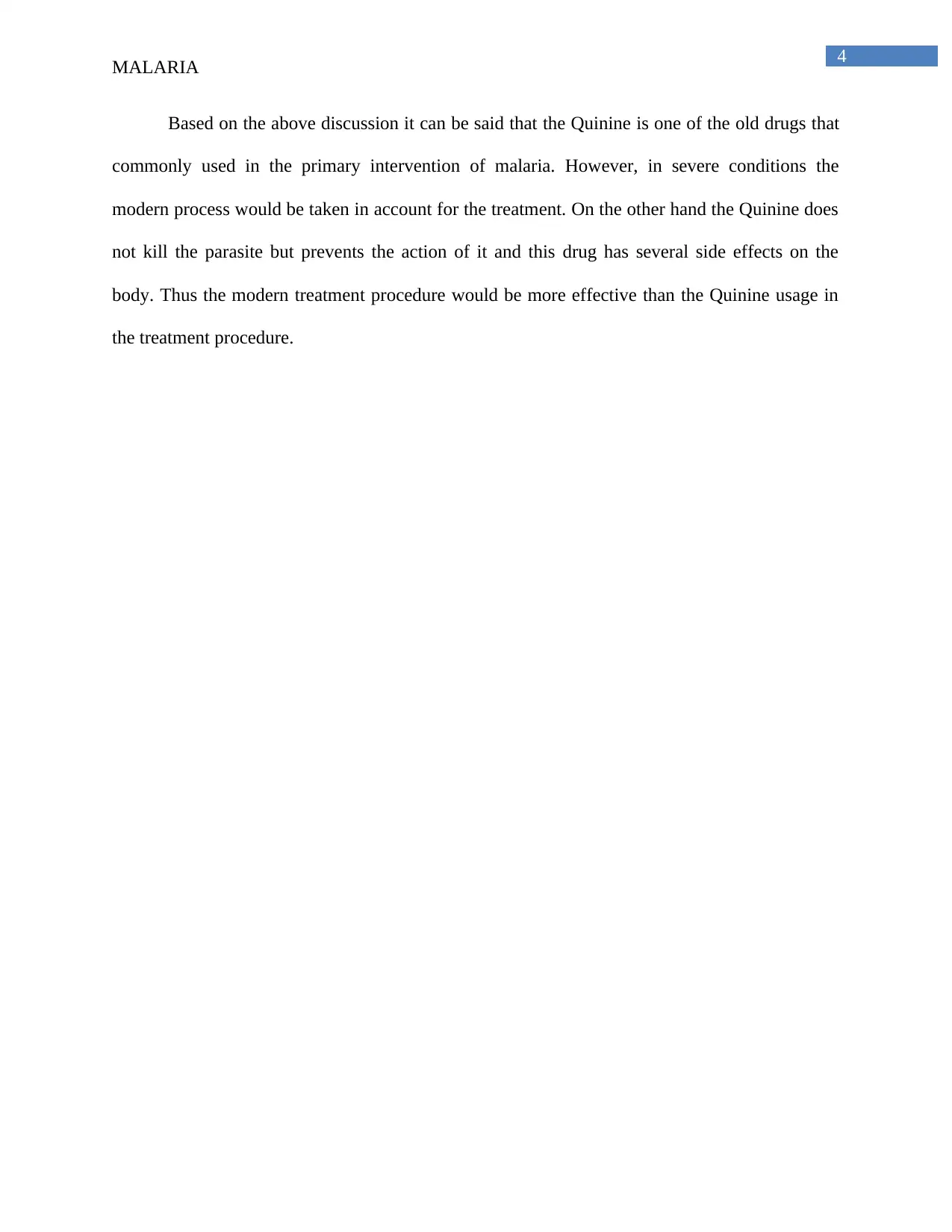
4
MALARIA
Based on the above discussion it can be said that the Quinine is one of the old drugs that
commonly used in the primary intervention of malaria. However, in severe conditions the
modern process would be taken in account for the treatment. On the other hand the Quinine does
not kill the parasite but prevents the action of it and this drug has several side effects on the
body. Thus the modern treatment procedure would be more effective than the Quinine usage in
the treatment procedure.
MALARIA
Based on the above discussion it can be said that the Quinine is one of the old drugs that
commonly used in the primary intervention of malaria. However, in severe conditions the
modern process would be taken in account for the treatment. On the other hand the Quinine does
not kill the parasite but prevents the action of it and this drug has several side effects on the
body. Thus the modern treatment procedure would be more effective than the Quinine usage in
the treatment procedure.
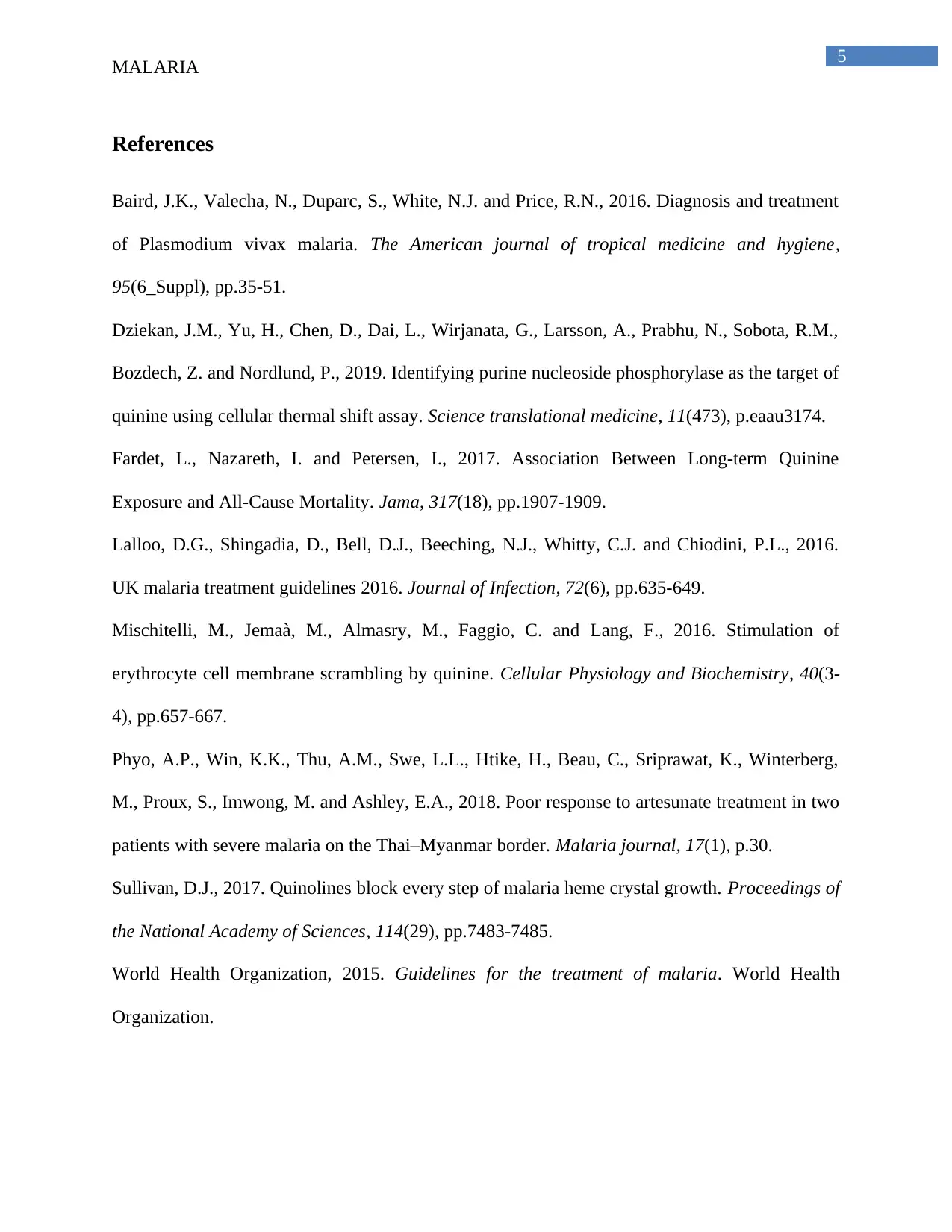
5
MALARIA
References
Baird, J.K., Valecha, N., Duparc, S., White, N.J. and Price, R.N., 2016. Diagnosis and treatment
of Plasmodium vivax malaria. The American journal of tropical medicine and hygiene,
95(6_Suppl), pp.35-51.
Dziekan, J.M., Yu, H., Chen, D., Dai, L., Wirjanata, G., Larsson, A., Prabhu, N., Sobota, R.M.,
Bozdech, Z. and Nordlund, P., 2019. Identifying purine nucleoside phosphorylase as the target of
quinine using cellular thermal shift assay. Science translational medicine, 11(473), p.eaau3174.
Fardet, L., Nazareth, I. and Petersen, I., 2017. Association Between Long-term Quinine
Exposure and All-Cause Mortality. Jama, 317(18), pp.1907-1909.
Lalloo, D.G., Shingadia, D., Bell, D.J., Beeching, N.J., Whitty, C.J. and Chiodini, P.L., 2016.
UK malaria treatment guidelines 2016. Journal of Infection, 72(6), pp.635-649.
Mischitelli, M., Jemaà, M., Almasry, M., Faggio, C. and Lang, F., 2016. Stimulation of
erythrocyte cell membrane scrambling by quinine. Cellular Physiology and Biochemistry, 40(3-
4), pp.657-667.
Phyo, A.P., Win, K.K., Thu, A.M., Swe, L.L., Htike, H., Beau, C., Sriprawat, K., Winterberg,
M., Proux, S., Imwong, M. and Ashley, E.A., 2018. Poor response to artesunate treatment in two
patients with severe malaria on the Thai–Myanmar border. Malaria journal, 17(1), p.30.
Sullivan, D.J., 2017. Quinolines block every step of malaria heme crystal growth. Proceedings of
the National Academy of Sciences, 114(29), pp.7483-7485.
World Health Organization, 2015. Guidelines for the treatment of malaria. World Health
Organization.
MALARIA
References
Baird, J.K., Valecha, N., Duparc, S., White, N.J. and Price, R.N., 2016. Diagnosis and treatment
of Plasmodium vivax malaria. The American journal of tropical medicine and hygiene,
95(6_Suppl), pp.35-51.
Dziekan, J.M., Yu, H., Chen, D., Dai, L., Wirjanata, G., Larsson, A., Prabhu, N., Sobota, R.M.,
Bozdech, Z. and Nordlund, P., 2019. Identifying purine nucleoside phosphorylase as the target of
quinine using cellular thermal shift assay. Science translational medicine, 11(473), p.eaau3174.
Fardet, L., Nazareth, I. and Petersen, I., 2017. Association Between Long-term Quinine
Exposure and All-Cause Mortality. Jama, 317(18), pp.1907-1909.
Lalloo, D.G., Shingadia, D., Bell, D.J., Beeching, N.J., Whitty, C.J. and Chiodini, P.L., 2016.
UK malaria treatment guidelines 2016. Journal of Infection, 72(6), pp.635-649.
Mischitelli, M., Jemaà, M., Almasry, M., Faggio, C. and Lang, F., 2016. Stimulation of
erythrocyte cell membrane scrambling by quinine. Cellular Physiology and Biochemistry, 40(3-
4), pp.657-667.
Phyo, A.P., Win, K.K., Thu, A.M., Swe, L.L., Htike, H., Beau, C., Sriprawat, K., Winterberg,
M., Proux, S., Imwong, M. and Ashley, E.A., 2018. Poor response to artesunate treatment in two
patients with severe malaria on the Thai–Myanmar border. Malaria journal, 17(1), p.30.
Sullivan, D.J., 2017. Quinolines block every step of malaria heme crystal growth. Proceedings of
the National Academy of Sciences, 114(29), pp.7483-7485.
World Health Organization, 2015. Guidelines for the treatment of malaria. World Health
Organization.
⊘ This is a preview!⊘
Do you want full access?
Subscribe today to unlock all pages.

Trusted by 1+ million students worldwide
1 out of 6
Related Documents
Your All-in-One AI-Powered Toolkit for Academic Success.
+13062052269
info@desklib.com
Available 24*7 on WhatsApp / Email
![[object Object]](/_next/static/media/star-bottom.7253800d.svg)
Unlock your academic potential
Copyright © 2020–2025 A2Z Services. All Rights Reserved. Developed and managed by ZUCOL.





